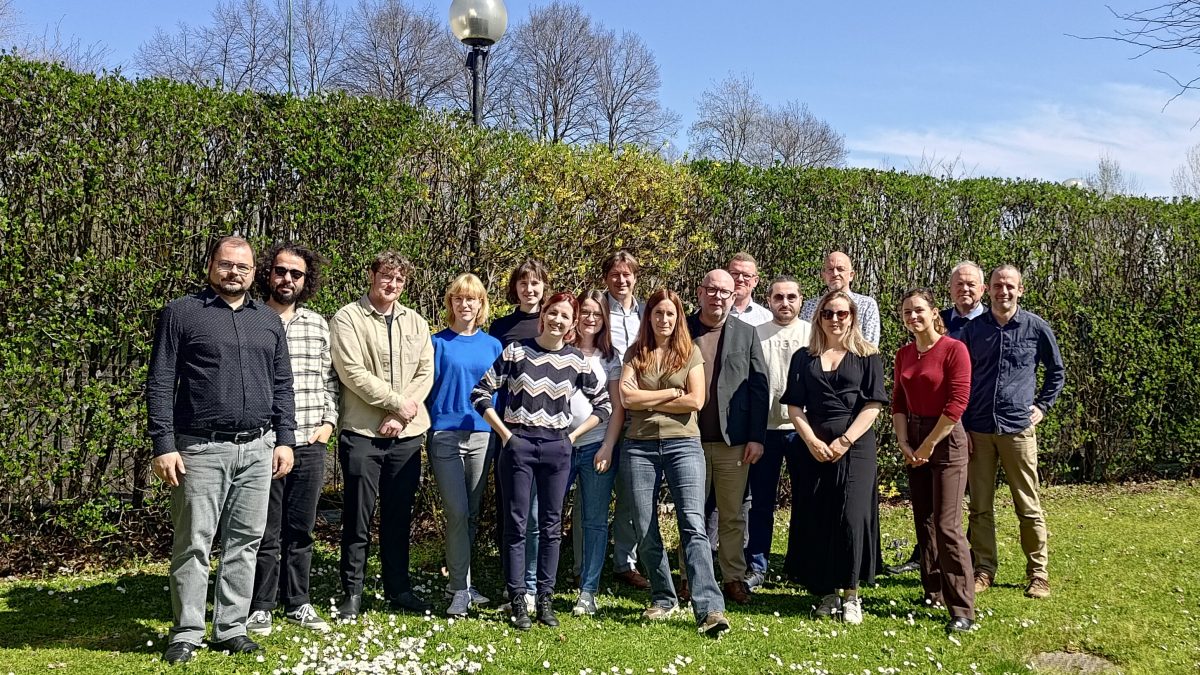Germany’s professional practice in the fields of extremism prevention, democracy promotion, and civic education is characterised by a notably high number and diversity of knowledge networks. These networks aim to connect civil society and state actors, facilitate professional exchange, and thereby strengthen the overall professionalisation of the field. In a European study on national and regional P/CVE networks, Dzhekova et al. (2024) highlight the unique German context:
‘In some countries, such as Germany, the multitude of actors involved in this work at state (province) level and the diversity of P/CVE programmes require stronger networking and exchange of experience between practitioners (but also with research and policy) to ensure the professionalisation of the field.’
During the 2020–2024 funding period of the federal programme ‘Live Democracy’, a total of fourteen so-called competence centres were funded, including the Competence Network on Right-Wing Extremism (KompRex) and the Competence Centre for the Prevention of Islamism (KN:IX). In the new funding period which began in 2025, these centres turned into the cooperation networks Competent in Right-Wing Extremism Prevention(KompRex, n.d.) and KN:IX connect (KN:IX connect, n.d.). Additionally, these phenomenon-specific networks are supplemented by others that deal specifically with counselling practice for exit and distancing/deradicalisation work, mobile counselling and counselling for victims and others affected by violent extremism.
The the very same federal programme has seen the building of a comprehensive evaluation infrastructure. While ‘scientific company’ of individual funded projects and the programme as a whole has been an integral part of the federal programme from the beginning, as well as in previous programmes, the third funding period is accompanied by an evaluation network, consisting of six research institutes (BMI, n.d.).
A significant contribution to professionalising German prevention practice in recent years regarding evaluation, importantly also beyond such programme structures as ‘Live democracy!’, has been the research and transfer project PrEval Zukunfswerkstätten. For the first time, it systematically surveyed evaluation capacities both nationally (Uhl et al. 2022) and internationally, with a view to deriving recommendations for Germany (Baykal et al. 2021; Bressan et al. 2024). It also identified the needs of practitioners regarding evaluation (Koynova et al. 2022), presented relevant methods (e.g. Klemm and Strobl 2024), and conducted pilot studies (e.g. Kindlinger et al. 2025). In addition, PrEval developed various support formats to foster methodological capacity-building and facilitate knowledge transfer within the field. Internationally, the project is considered exemplary for advancing the professionalisation of evaluation and quality assurance in the fields of extremism prevention, democracy promotion, and civic education.
One particular study analysed the need for support formats among practitioners and how they could be integrated into existing knowledge networks (Koynova et al. 2024). A visibility analysis showed that although various networks exist in the fields of extremism prevention, democracy promotion and civic education, there are hardly any publicly visible references to evaluation or quality assurance (Ibid., 26; cf. Tschöp et al. 2023). Nevertheless, in a follow-up survey, which primarily reached evaluators, six networks were named as relevant networks dealing with the topics of evaluation and quality assurance (ibid.). However, there were specific preferences regarding the type of network in which such topics were discussed. The authors found that ‘while practitioners (…) tend to describe access to thematically relevant networks in which they also exchange information on other issues in their fields of work, participants from academia or evaluation (…) predominantly describe access to networks focussing on evaluation and quality assurance, with which they are already familiar due to their focus of work […]’ (Tschöp et al. 2023, 8; translated from German; Koynova et al. 2024, 27).
While no explicit reference to evaluation was found in the networks most frequently used by practitioners, it was assumed that internal exchanges on these topics do occur. Yet, the needs assessment clearly demonstrated practitioners’ need for exchange on evaluation and quality assurance, as well as for concrete support for evaluation projects (Koynova et al. 2022). To fill this gap, the authors of the PrEval study recommended to systematically strengthen the visibility and discoverability of relevant evaluation expertise within existing networks (Koynova et al., 2024, 27-28). Drawing on both the needs assessment and the visibility analysis of existing networks, several support formats were developed that can either be integrated into existing knowledge networks or serve to strengthen connections between them (ibid., 33). One such format is the ongoing counselling series ‘Evaluation and Quality Assurance’, currently piloted by the Violence Prevention Network and i-unito. The initiative is designed to support civil society organisations in developing and implementing evaluation and quality assurance processes. The programme offers modular support in areas such as designing impact models, defining indicators, developing data collection instruments, and analysing evaluation data (Giel 2025).
Another complementary project dealt with the conception of a helpdesk for evaluation and quality assurance in the fields of extremism prevention, democracy promotion and civic education in Germany. Surveying for needs among practitioners revealed that some would like to link such a service to established civil society organisations or networks in order to avoid any competitive dynamics (Ruf et al. 2024, 13). It was found that these networks already function as trustworthy contact points (ibid., 20) and that their use could help to avoid duplicate structures in the already complex prevention landscape (ibid., 27).
With the conclusion of the PrEval project at the end of 2025, a comprehensive body of knowledge is now available, both on the needs of practitioners and other stakeholders, and on how to implement practice-oriented support formats. Moreover, there are early experiences with piloting these formats. Key ‘products’ of the project such as the ideas and pilots of an evaluation database, low-threshold support formats, and the counselling series represent essential tools that can advance the professionalisation of evaluation and quality assurance in the field.
The next crucial step is to maintain these formats and embed them institutionally. Since PrEval opened spaces to discuss evaluation beyond specific funding structures, existing knowledge networks lend themselves well for this purpose. While networks such as KN:IX are financed by ‘Live Democracy!’, they are not limited to projects of this funding structure. Moreover, their bottom-up character are well suited to discuss sensitive topics such as evaluation in an environment that is perceived as ‘safe’. Research on the institutionalisation of evaluation shows that such a process cannot succeed without a broader system of professionalisation (Meyer, Stockmann and Taube, 2020; cf. Stockmann and Meyer, 2016). Core components of such a system include structured training opportunities, peer learning formats, and shared professional standards. As several PrEval studies have highlighted, linking emerging support formats to established thematic knowledge networks could offer a practical pathway to strengthening a ‘system of professionalisation’.
However, the success of this transfer largely depends on the capacities and resources available within those networks. The expertise developed within PrEval since 2020 is therefore more than just an output of the project – it is a critical enabler for future institutionalisation efforts. In other European countries, where civil society plays a less prominent role in prevention, there are typically fewer knowledge networks in the P/CVE field and related areas, as well as fewer research projects that explicitly research evaluation and invest in capacity building. Some isolated initiatives exist, such as institutionalised helpdesks in the Netherlands or best practice exchange formats in Denmark, but these are usually state-led and primarily target municipalities. By contrast, Germany’s knowledge networks provide alternative avenues to embed exchange and support formats for evaluation within civil society practice. The challenge now is to fully leverage this potential.
Sources
Baykal, Asena, Sarah Bressan, Julia Friedrich, Giulia Pasquali, Philipp Rotmann, and Marie Wagner. 2021. ‘Evaluating P/CVE: Institutional Structures in International Comparison’. GPPi; PrEval (PRIF). https://preval.hsfk.de/fileadmin/HSFK_Preval/GPPi_2021_Extremismuspraevention_evaluieren_Institutionelle_Strukturen_i….pdf.
BMI. n.d. ‘Evaluation’. https://www.demokratie-leben.de/dl/programm/evaluation.
Bressan, Sarah, Sophie Ebbecke, and Lotta Rahlf. 2024. ‘How Do We Know What Works in Preventing Violent Extremism? Evidence and Trends in Evaluation from 14 Countries’. Berlin: GPPi; PrEval (PRIF). https://gppi.net/assets/BressanEbbeckeRahlf_How-Do-We-Know-What-Works-in-Preventing-Violent-Extremism_2024_final.pdf.
Dzhekova, Rositsa, Maximilian Ruf, Sophie Kuijper, Margareta Wetchy, and David Tschöp. 2024. ‘National and Regional Networks Focusing on P/CVE across the EU’. Radicalisation Awareness Network. https://home-affairs.ec.europa.eu/document/download/b70fc126-5856-498b-a5c6-abb5d88299b3_en?filename=ran_national_regional_networks_focusing_on_P-CVE_across_EU_en.pdf.
Giel, Susanne. 2025. ‘Beratungsreihe Evaluation und Qualitätssicherung’. Frankfurt am Main: PrEval Consortium. https://preval.hsfk.de/fileadmin/PrEval/PrEval-Beratungsreihe/PrEval-Beratungsreihe_Evaluation_und_Qualit%C3%A4tssicherung_gesamt.pdf.
Kindlinger, Marcus, Lucy Huschle, and Hermann Josef Abs. 2025. ‘Entwicklung eines integrierten Modells und Selbsteinschätzungsinstruments für Digital Citizenship Literacy’. PrEval Studie 1. Frankfurt am Main: PrEval Consortium. https://preval.hsfk.de/fileadmin/PrEval/PrEval_Studie_1_2025.pdf.
Klemm, Jana, and Rainer Strobl. 2024. ‘Wirkungsmodelle und ihr Potenzial für Evaluation und Qualitätssicherung in der Demokratieförderung’. PrEval Expertise. Frankfurt am Main: PrEval Consortium. https://preval.hsfk.de/fileadmin/PrEval/PrEval_Expertise_01_2024.pdf.
KN:IX connect. n.d. ‘Islamistische Radikalisierung geschieht nicht im luftleeren Raum’. KN:IX Connect. n.d. https://kn-ix.de/.
Kober, Marcus, Lotta Rahlf, Mikhail Logvinov, Julian Junk, Helle Becker, and Marcus Kindlinger. 2024. ‘Zukunftswerkstatt “Evaluationsdatenbank”: Bericht’. Frankfurt am Main: PrEval Consortium. https://preval.hsfk.de/fileadmin/PrEval/Bericht_ZW_Evaluationsdatenbank.pdf.
KompRex. n.d. ‘Das Netzwerk’. Kompetenz Netzwerk Rechtsextremismus Prävention. n.d. https://kompetenznetzwerk-rechtsextremismuspraevention.de/das-netzwerk/.
Koynova, Svetla, Lina Hartmann, Moritz Lorenz, David Tschöp. 2024. ‚Bericht der Zukunftswerkstatt Wissensnetzwerke‘. Frankfurt am Main: PrEval Consortium. https://preval.hsfk.de/fileadmin/PrEval/Bericht_ZW_Wissensnetzwerke.pdf.
Koynova, Svetla, Alina Mönig, Matthias Quent, and Vivienne Ohlenforst. 2022. ‘Monitoring, Evaluation und Lernen: Erfahrungen und Bedarfe der Fachpraxis in der Prävention von Rechtsextremismus und Islamismus’. 7. Frankfurt am Main: Leibniz-Institut Hessische Stiftung Friedens- und Konfliktforschung (HSFK). https://www.hsfk.de/fileadmin/HSFK/hsfk_publikationen/PRIF_Report_7_2022_barrierefrei.pdf.
Meyer, Wolfgang, Reinhard Stockmann, and Lena Taube. 2020. ‘The Institutionalisation of Evaluation: Theoretical Background, Analytical Concept and Methods’. In The Institutionalisation of Evaluation in Europe, edited by Wolfgang Meyer, Reinhard Stockmann, and Lena Taube, 3–36. Cham: Palgrave Macmillan. https://doi.org/10.1007/978-3-030-32284-7_1.
Ruf, Maximilian, David Tschöp, Janusz Biene-Clément, Moritz Lorenz, Alina Mönig, Toqa Hilal. 2024. ‚Bericht der Zukunftswerkstatt Helpdesk.‘ Frankfurt am Main: PrEval Consortium. https://preval.hsfk.de/fileadmin/PrEval/Bericht_ZW_Helpdesk.pdf.
Stockmann, Reinhard, and Wolfgang Meyer. 2016. ‘The Future of Evaluation: Global Trends, New Challenges and Shared Perspectives’. In The Future of Evalaution: Global Trends, New Challenges, Shared Perspectives, edited by Reinhard Stockmann and Wolfgang Meyer, 9–19. London: Palgrave Macmillan. https://doi.org/10.1057/9781137376374.
Tschöp, David, Emma van Heeswijk, Lina Hartmann, Benedikt Büchsenschütz. 2023. ‚Auf der Suche nach Expertise. Die Schwierigkeiten bei der Auffindbarkeit von Wissensnetzwerken und Evaluationsexpertise in der Demokratieförderung, Extremismusprävention und politischen Bildung.‘ PrEval Working Paper 1. Frankfurt am Main: PrEval Consortium. https://preval.hsfk.de/fileadmin/PrEval/Working_Paper_AP5_21.09..pdf
Uhl, Andreas, Manuela Freiheit, Benjamin Zeibig, and Andreas Zick. 2022. ‘Evaluationskapazitäten im Bereich der Extremismusprävention und der politischen Bildung in Deutschland’. 9. Frankfurt am Main: Leibniz-Institut Hessische Stiftung Friedens- und Konfliktforschung (HSFK). https://doi.org/10.48809/prifrep2209.










